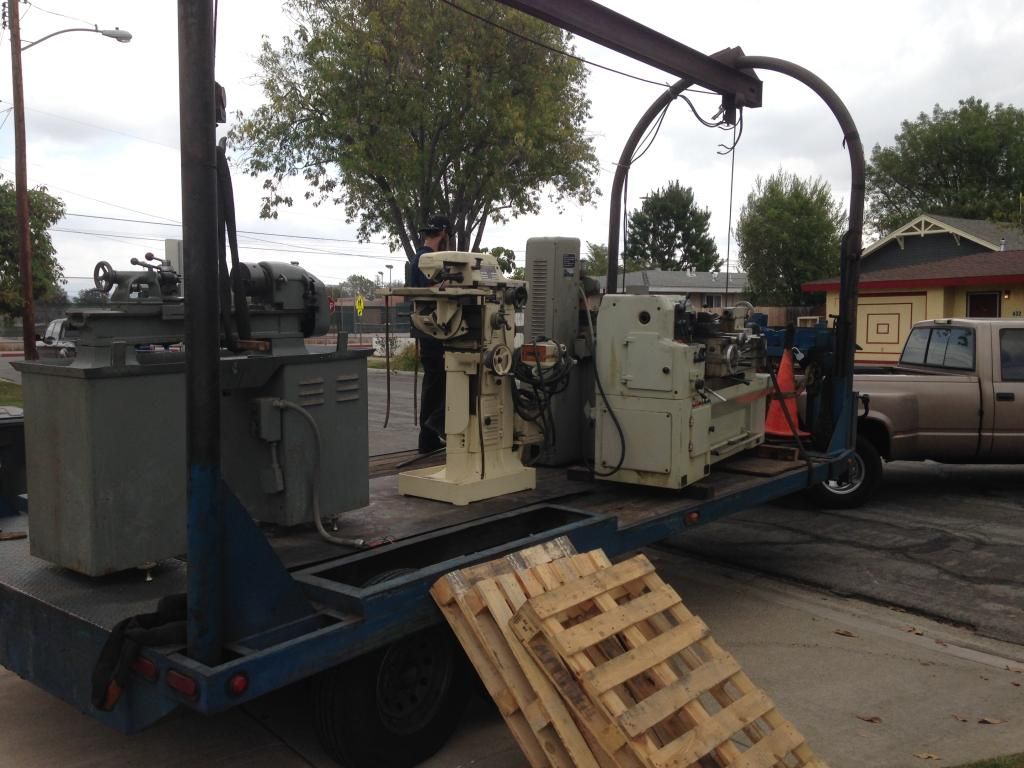traditional-tools
Diamond
- Joined
- Aug 10, 2007
- Location
- West Coast
Well, been using my FP1 quite a bit lately, doing several projects and getting more familiar with it.
Like always, it never seem like one can have enough tooling...I recently bought a few MK4 collets for Stan Krum here on PM, which came in handy as I used 2 of them for this project. I also found out that the collet can't be removed from the horizontal spindle without rotating the vertical head out of the way...that left me with my 5/16" collet in the spindle with a piece of drill rod in it. I leave that in there so chips don't get in the spindle...but luckily I bought a set of the spring collets from byawor, and ended up using 2 of those including the 5/16".
I am working on a 1911 pistol also, but in California the penal code is changing for single shot exemption, and as best I can tell, it will not be possible to create a pistol with the potential to be come a semi-automatic after Jan. 1st. Because of that I wanted to have an AR pistol, so milled this out this past weekend.
I think I need to replace my bearings on the drive shaft. When ballen was visiting he mentioned that might be the case and would be something to look at, but at that time we didn't get very much time to run it. In running the mill more, I do believe the noise I've heard and suspected was in the motor, is actually in the driveshaft bearings, being echoed through the opening for the motor arbor to attach to the pulley/belt. Anyway, that's a project for the future for certain.
The jig I used is not the best, and it was difficult to keep it flush, the bottom wanted to pinch in with the jaws on my Kurt vise. So I used 4 x 1-2-3 blocks to hold it solid. Seemed to work ok for this purpose.
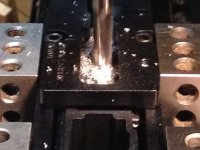
Pockets are rough finished.
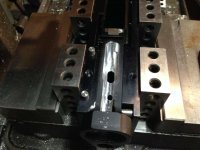
Cleaning up the walls, luckily I had a 3/8" end mill with 2" of cutter lenght to handle this.

Milling is complete, cleaned up, and narrow passage connecting front/rear of trigger pocket is to size.

Here's the finished lower, officially a pistol lower. It is important to note that I built a pistol, not a rifle, as this will host a 10.5" upper with a Sig Sauer Stabilizing Brace (sanctioned by the ATF to not be a stock, and permissible to shoulder as such and not be classified as a Short Barrel Rifle).
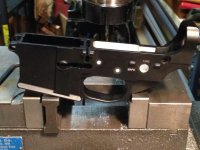
This was my first AR, and honestly I wasn't crazy about building one as there is not too much to it. With the pistol laws changing in California, I was encouraged to make this one. I can make more AR rifles in the future if I want, that wouldn't be a problem, but pistols will. I have a 1911 frame and slide I've been working on also, and have done much of it on the Deckel also...this has all been a learning process in understanding the FP1 for me.
NOTE: As an aside, I had to lower to speed to 190 on the vertial head when taking a 1.250" cut along the walls, otherwise I would get too much chatter on the 7075 T6. The end mill was HSS in this case, where I used a carbide bit to mill most of it...just that the cutter length was only 1" on the small end mill, so I couldn't do the full wall with it. When I had first calculated it seemed I should run the end mill a bit faster, but that just didn't work in the real world for me. I could only take about .010"-.015" on a pass, at about 1.8 ipm.
Cheers,
Alan (enjoying his humble and antiquated Deckel FP1)
Like always, it never seem like one can have enough tooling...I recently bought a few MK4 collets for Stan Krum here on PM, which came in handy as I used 2 of them for this project. I also found out that the collet can't be removed from the horizontal spindle without rotating the vertical head out of the way...that left me with my 5/16" collet in the spindle with a piece of drill rod in it. I leave that in there so chips don't get in the spindle...but luckily I bought a set of the spring collets from byawor, and ended up using 2 of those including the 5/16".
I am working on a 1911 pistol also, but in California the penal code is changing for single shot exemption, and as best I can tell, it will not be possible to create a pistol with the potential to be come a semi-automatic after Jan. 1st. Because of that I wanted to have an AR pistol, so milled this out this past weekend.
I think I need to replace my bearings on the drive shaft. When ballen was visiting he mentioned that might be the case and would be something to look at, but at that time we didn't get very much time to run it. In running the mill more, I do believe the noise I've heard and suspected was in the motor, is actually in the driveshaft bearings, being echoed through the opening for the motor arbor to attach to the pulley/belt. Anyway, that's a project for the future for certain.
The jig I used is not the best, and it was difficult to keep it flush, the bottom wanted to pinch in with the jaws on my Kurt vise. So I used 4 x 1-2-3 blocks to hold it solid. Seemed to work ok for this purpose.

Pockets are rough finished.

Cleaning up the walls, luckily I had a 3/8" end mill with 2" of cutter lenght to handle this.

Milling is complete, cleaned up, and narrow passage connecting front/rear of trigger pocket is to size.

Here's the finished lower, officially a pistol lower. It is important to note that I built a pistol, not a rifle, as this will host a 10.5" upper with a Sig Sauer Stabilizing Brace (sanctioned by the ATF to not be a stock, and permissible to shoulder as such and not be classified as a Short Barrel Rifle).

This was my first AR, and honestly I wasn't crazy about building one as there is not too much to it. With the pistol laws changing in California, I was encouraged to make this one. I can make more AR rifles in the future if I want, that wouldn't be a problem, but pistols will. I have a 1911 frame and slide I've been working on also, and have done much of it on the Deckel also...this has all been a learning process in understanding the FP1 for me.
NOTE: As an aside, I had to lower to speed to 190 on the vertial head when taking a 1.250" cut along the walls, otherwise I would get too much chatter on the 7075 T6. The end mill was HSS in this case, where I used a carbide bit to mill most of it...just that the cutter length was only 1" on the small end mill, so I couldn't do the full wall with it. When I had first calculated it seemed I should run the end mill a bit faster, but that just didn't work in the real world for me. I could only take about .010"-.015" on a pass, at about 1.8 ipm.
Cheers,
Alan (enjoying his humble and antiquated Deckel FP1)





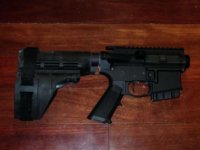

 (live and learn) I'm a bit more careful about that now...but you really need 3 hands for that operation...or place a board under the bit and/or place something soft so the bit doesn't crash on the tooling/table/work.
(live and learn) I'm a bit more careful about that now...but you really need 3 hands for that operation...or place a board under the bit and/or place something soft so the bit doesn't crash on the tooling/table/work. 